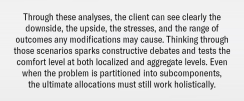As investors become increasingly focused on outcomes, portfolio managers are tasked with developing strategies to manage the portfolio toward those outcomes, prioritize multiple objectives, and incorporate a range of constraints and multi-period challenges into the plan.
The process often begins with a review of a portfolio’s current exposures, along with an assessment of a client’s specific objectives. “It’s the foundation upon which we start building the most appropriate solution to best achieve the metrics and measures the client is trying to maximize,” says Nick Savoulides, Head of Investment Solutions Research at Invesco.
Allocations should ideally incorporate a comprehensive set of goals across the entire portfolio and for each allocation’s role within the broader portfolio context. For instance, in today’s low yield environment, a fixed income manager may be challenged to beat cash and consider potential adjustments to its investment approach. However, that fixed income allocation must still consider the entire portfolio’s strategic context and exposures, and any adjustments must seek to ensure the “localized” view does not conflict at the aggregate, holistic level.
Similarly, cross correlations within the portfolio must be identified to avoid unintended overlaps that may amplify or cancel out desired exposures; for example, within equity portfolios, a growth orientation in one component of the portfolio may neutralize the value tilt of another.

In addition to addressing the complex interactions among assets within the portfolio, the grand plan must sometimes address seemingly incompatible aims, such as hedging while generating growth. The plan’s architects become jugglers, balancing an array of goals, constraints, approaches, and investment solutions all at once, seeking to align all the elements to achieve desired outcomes.
Goals and objectives
At the heart of the plan are the investor’s key priorities. Investment approaches may include:
- Matching liabilities
- Benchmarks
- Funding ratio volatility
- Liquidity
- Hedging
- Target dates
This approach tailors the objectives and constraints of the investment strategy to the client’s specific context, with appropriate risks and investment strategies evaluated based on their needs. For one client, the discussion may emphasize hedging strategies to align long-term interest rate sensitivities with funding, while another client engagement may focus on an appropriate mix of assets to address its underfunded status.
Is your private markets strategy optimized for growth and income? Find out.
Liability driven investing (LDI) is a central concept for matching the interest rate sensitivities required to fund future liabilities. A similar approach, cash flow driven investing (CDI), maps cash flows to the liabilities to more precisely match capital to the liability stream. These approaches may also be blended, with CDI at the front end to manage near-term capital flows and LDI farther out to manage long-term liabilities. These complex, multi-phase investment challenges require thoughtful planning around long-term strategy. “You need to make sure that you’ve got capital on hand, managing both a hedging portfolio, and putting in some growth assets to make sure you can meet payments in any given year of a plan and there aren’t any shortfalls,” says Blundell. He describes the juggling act: “We’ve got cash on hand, we’re managing to the benchmark, we’re optimizing the portfolio, and we’re making sure there’s no shortfall.”
Another type of outcome-oriented investing focuses on individual goals, including saving for college or retirement. The planning begins with the target date and amount needed, and then examines any funding shortfall and a glide path constructed to reduce risks over time. “We created a 529 plan,” says Savoulides. “You need X-amount of dollars for when your child is ready for college. What’s the inflation rate and how do you measure that? What do you need to save during that time period, and what is the ideal portfolio mix over that time frame? How do you make sure you don’t have a funding shortfall, to ensure your child has adequate savings through college? What does the glide path look like? We’ll run target date and target risk analysis, and we can determine a mix of equities and other asset classes, including alternatives, over the course of the investment.”
A complex process
The agenda kicks off with a thorough understanding of the portfolio and the client’s needs, and an analysis of the risks. What is in the current portfolio? What is the rationale behind the strategic asset allocation? What are the criteria for selecting managers? Is the portfolio more benchmark or liability-driven?
Next follows a very iterative conversation with the client to develop an ongoing exchange of views. Having a second set of eyes may provide useful perspective. The conclusion of these discussions is geared toward implementing a streamlined result. There is no one-size-fits-all, or even one perfect solution for any particular client. “Typically, we establish common frameworks to help us solve the problem in the most systematic possible way,” says Savoulides.
There’s diversification, and then there’s diversification achieved through factor-based analytics. Learn more about the difference.
That means looking at the fundamental drivers through a diagnostics platform and running stress scenarios. Through these analyses, the client can see clearly the downside, the upside, the stresses, and the range of outcomes any modifications may cause. Thinking through those scenarios sparks constructive debates and tests the comfort level at both localized and aggregate levels. Even when the problem is partitioned into subcomponents, the ultimate allocations must still work holistically.
The Invesco team lends its expertise to modeling the different asset classes in the portfolio and how they interact. It is inevitable that complexity increases with multiple objectives, as well as with the additional data inputs. For example, there could be elements of a portfolio that are potentially faster-moving, more complex, or more alternative – adjusting those nuances in one part of the portfolio can cause indirect implications in another part of it. So, while the layers keep growing, complexity pays off in the end, resulting in a more optimal balance. Blundell adds, “With more building blocks and more information, we’re in a better position to customize and optimize a specific solution for our client.”
Start the conversation to better outcomes. Learn more.
Helpful resources:
2019 Long-term capital market assumptions
All content provided by Invesco is for informational purposes only and is not an offer to buy or sell any financial instruments.
The opinions expressed are those of the authors, are based on current market conditions and are subject to change without notice. These opinions may differ from those of other Invesco investment professionals.
Invesco Advisers Inc. is an investment adviser; it provides investment advisory services to individual and institutional clients and does not sell securities.
Asset allocation, diversification and low or negative correlation do not guarantee a profit or eliminate the risk of loss.
Alternative products typically hold non-traditional investments and may employ complex trading strategies. Investors considering alternatives should be aware of their unique characteristics and additional risks from the strategies they use.






